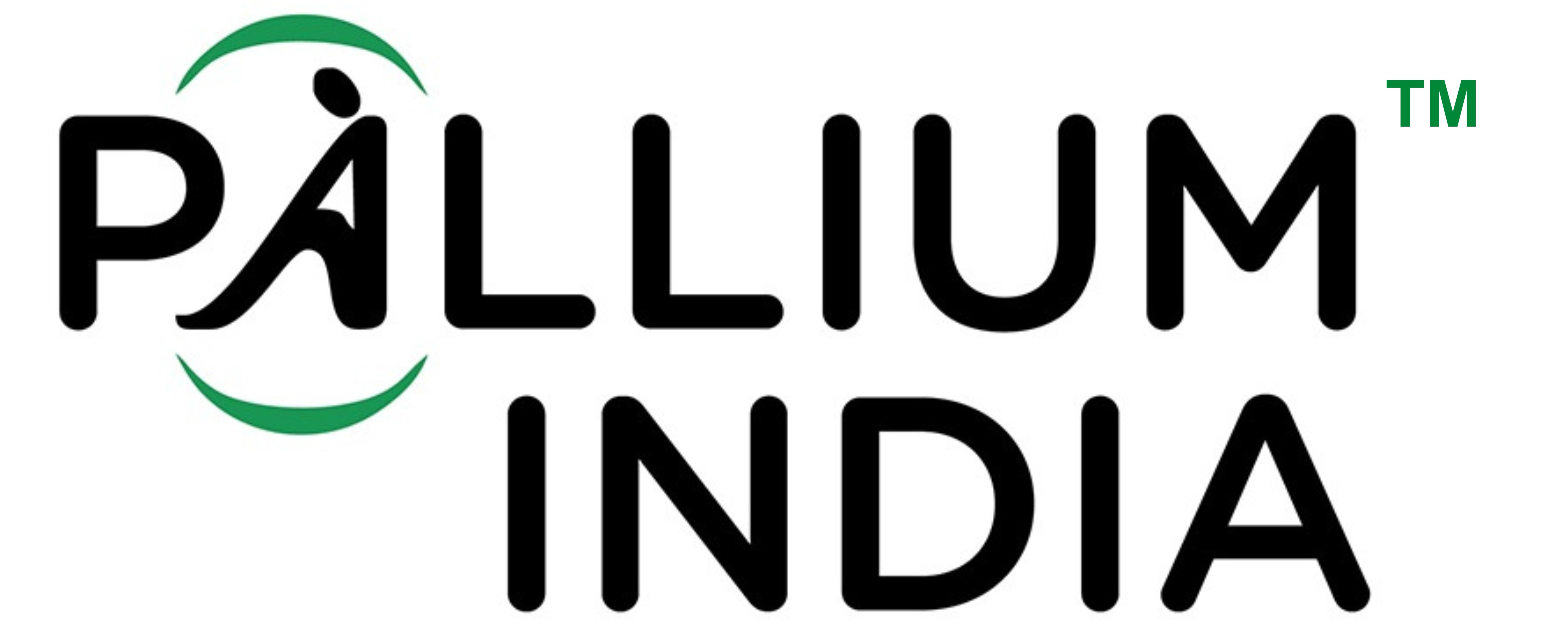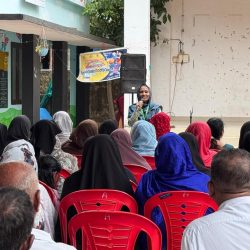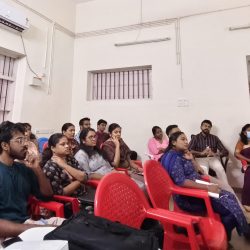March 2011
 We are sorry to start this issue with some sad news from our friend and benefactor, Mr Bruce Davis. He wrote to tell us that Ms Val Hunkin, a great friend of Indian palliative care and one who has taught communication skills to many many of us, died of advanced cancer this week.
We are sorry to start this issue with some sad news from our friend and benefactor, Mr Bruce Davis. He wrote to tell us that Ms Val Hunkin, a great friend of Indian palliative care and one who has taught communication skills to many many of us, died of advanced cancer this week.
Val was taken ill a year and half back while on a cruise, she was taken to a hospital in the USA and given the diagnosis of cancer. She has had a tough fight with the disease, supported by her dear friend Jeni and many others.
Goodbye, Val. You were a great friend. You touched a lot of lives in India. Thank you.
–
Thank you, Mr Excise Commissioner!
Mr Piyush Gupta, Secretary of Cancer Aid Society, has worked hard in Uttar Pradesh (U.P.) and neighboring states for palliative care advocacy.
Most of the few palliative care services in Uttar Pradesh have been catalysed by his activity, and his interactions with the U.P. Government for improved opioid availability have also been very fruitful.
Piyush writes to inform us that Mr. M.K. Gupta, Excise Commissioner of U.P., has issued a circular to concerned officials in the state to cooperate in the matter of licensing medical institutions for morphine.
Those in U.P. can download the circular (in Hindi) below; you may need it to support an application for morphine licensing:
- Download: up-excise-morphinecircular.pdf (180kb)
Thank you Mr Gupta.
–
Pallium India is Getting Social!
Pallium India has started a new public Facebook Page which will allow us to reach out to many more people around the World:
www.facebook.com/palliumindia
Please click the “Like” button on the page and stay up-to-date on news and information, connect with like-minded others, and share your own thoughts, experiences and questions.
(This will eventually replace our current member-only Facebook Group)
–
Sunshine’s Letter from Trivandrum
Sunshine Mugrabi is a writer and PR professional who spent a month volunteering with Pallium India at its headquarters in Trivandrum, Kerala, India. She is a member of the Pallium India USA core committee. This is her “Letter from Trivandrum”:
Smiles. I am seeing them everywhere in India. To my surprise, many of the most radiant are on the faces of Pallium India’s patients.
I’m here in Trivandrum to get a first hand look at the organization’s work. I first met Dr. M.R. Rajagopal, founder and chairman of Pallium India at a conference on Hospice and Palliative Care in the Global Community, held last fall at UCSF Fresno and sponsored by Hinds Hospice.
One of the first patients I encounter here is a 53-year-old woman with a rare, extremely painful and serious condition known as systemic sclerosis. Dr. Rajagopal treats her at the organization’s Pain and Palliative Care Unit, which is a joint project with the local S.U.T Hospital. He sets her immediately at ease – something I’ll see over and over again. It’s hard not to be in awe of his competent, compassionate care.
This woman’s condition means she is slowly losing her fingertips, which she shows me by laying her hands on the table. One of her toes and part of another have also needed amputation — all of this due to her blood supply being cut off by the sclerosis. Upon her original diagnosis, she was given three months to live. That was five years ago. By some sort of miracle or effort of will, she continues on. Even more unbelievably, she does it with a smile.
Dr. Rajagopal tells me her attitude continually amazes him.
“She is my guru,” he says, referring to the almost godlike air around her and her ability to handle immense pain and uncertainty about her future.
It’s not what anyone would imagine seeing on the face of a person who is often at a “10” on the pain scale. (This scale starts at “0” for no pain and runs to “10” for the worst pain imaginable.) Her smile is a wide as her face, accompanied by a bright twinkle in her bright blue-gray eyes. Her cracked teeth are spaced far apart. When she smiles it looks as if her entire being is infuse
d by some wellspring of private joy. Pain cannot touch it, and in this, she touches everyone around her.
Later on she shows me to her hospital room, where her daughter is sitting on the edge of one of the beds, nursing her baby in her lap. The other child, a little girl of perhaps five or six, hides shyly behind grandma’s skirts. Here are the living reasons she continues to travel here regularly from her village 220 km away to brave the delicate and painful procedure known as stellate ganglion neurolysis that Dr. Rajagopal performs to restore blood flow to her limbs, thus keeping her alive.
Now covered in a thin blue blanket, she lies on a gurney in the operating theater. Her eyes are open. She is given local anesthetic, never flinching as the needle enters her arm. After it takes effect, she calmly accepts the next step, application of a needle to her neck. Dr. Rajagopal carefully injects dye, which shows up on a computer screen in front of him. It looks like tiny black snail shell. I find out later that this is a procedure few doctors are willing to perform, because of the danger of accidentally hitting the nearby carotid artery and almost certainly killing the patient. After it’s over, she turns her head and gives me another one of her dazzling smiles.
A few days later I meet another patient, a 35-year-old man who suffered a terrible accident ten years ago. While working at a construction job, a wall collapsed on him, leaving him paralyzed from the waist down. His family’s livelihood was essentially wiped out. He lay in bed for years, distraught beyond imagining, until his upper body wasted away, as if it were also stricken with paralysis.
But that isn’t the person I meet.
In August 2009, after years o
f medical neglect, Pallium India stepped in and began treating the young man. They brought in a physiatrist — an MD who is a specialist in physical medicine — and a physical therapist.
The man who greets me is smiling and talking animatedly. His upper body shows plenty of muscle tone. The Pallium India physical therapy team rigged up a simple stick and rope device that enables him to sit up in bed. He is now moving his own legs with his hands and getting into his wheelchair with minimal help.
“He is feeling positive,” Dr. Rajagopal tells me. “Things aren’t perfect of course, but he’s able to contribute to the family and do things for himself.”
Pallium India also identified his family as needing further rehabilitation – of a financial nature. After being assessed by the social work team, Pallium provided the family with the initial investment needed to start a home vegetable selling business. This too is going well — so well, in fact, that there is talk on this visit of expanding it.
On one side of the small home there are shelves set aside for the vegetables. They are kept fresh, clean and neatly stacked in plastic bins. The young man contributes to the effort by chopping and cleaning from his bed. The business earns the family an income. Combined with day wages from the brother, it is sufficient to provide for their needs.
As an American, it’s hard for me to swallow the fact that there is no disability insurance in India. Still, watching the children run around the yard beaming with pleasure, I can’t help but feel that much good is coming to this family. The smiles all around me are contagious. Before I know it, one appears on my face as well.
–
More from an Iowa Student: Lessons Learned About Palliative Care in India
 We had recently reported (blog: Iowa Comes Back to Trivandrum!) about a 3–week course for students from the University of Iowa at Pallium India’s Trivandrum Institute of Palliative Science (TIPS).
We had recently reported (blog: Iowa Comes Back to Trivandrum!) about a 3–week course for students from the University of Iowa at Pallium India’s Trivandrum Institute of Palliative Science (TIPS).
Professor Joann Eland reports that Danielle Pittman, one of the students who underwent the three week cultural immersion course at TIPS, has written an article for the newsletter of Chicago Western Suburbs Chapter (CWSCONS) of the Oncology Nursing Society.
Read Danielle’s article below (PDF):
Lessons Learned About Palliative Care in India
By Guest Author Danielle Pittman – “Our Central Line”, Winter 2011 Volume 19, Issue 1
As a sophomore in the University of Iowa’s College of Nursing, I had the opportunity to take a three week course with 11 other students in Trivandrum, Kerala in southern India. The course, Pain, Palliative Medicine, and Hospice, was instructed by Dr. Joann Eland, Dr. M.R. Rajagopal, and various healthcare professionals working for Pallium India. Pallium India is a palliative care program that helps support the less fortunate throughout their illness. We spent three weeks exploring Kerala, learning from spectacular individuals, and making rounds with Pallium’s healthcare teams. I’ve never learned so much in such a short timeframe. The program we worked with brought us to patients who opened my eyes in such a way I didn’t know was possible.
One patient specifically made a difference in my life. We drove an hour and a half and hiked ten minutes to her home. The woman was suffering from breast cancer that has metastasized to her lungs and brain. In addition to the struggle of her health, she has been abandoned by her family and left with what little she had of a home with a concrete slab for a bed. This was a common occurrence with some of the families we visited. If a family member became chronically ill, occasionally a husband would leave his wife and children to support himself.
The one thing that really touched me was that even though we did not speak the language, we could watch the nonverbal interactions that the healthcare team had with this patient. They found a way to effectively use touch and silence without any interference. Doctors and nurses were in no rush whatsoever. They had no other patients to rush o to see, and their cell phones and pagers were turned off to give her their undivided attention. In the U.S., patience is some times hard to find.
It surprised me that even though this woman was suffering from a severe illness, she still welcomed us into her home. She allowed us to photograph her, offered us a place to sit, and even reached out so we could hold her hand in comfort. I’ll never understand the impact we had in her life just by visiting and giving her the touch that was missing in her life. I only hope that when visitors come to see me, I can make them feel as welcome.
On one long trek to a patient’s home, we stopped on the side of a road to meet a woman who traveled six miles on foot to meet us for medicine for her paralyzed husband. Their home was not accessible for us because there were other patients in need. Pallium supplied his wife with medication, assessed his status the best they could, and set up a date and me that they would meet again. Since there is such a high demand for care, Pallium India has to make do with the me, supplies, and professionals that they have.
Collusion was another cultural difference that was jaw dropping for most of us. In India, patient diagnoses are divulged to the family instead of the individual. Most of the time, patients won’t know what illness they have until they go to an “oncology clinic” or until their families tell them. I think it is important that nurses be aware of these practices in order to provide culturally sensitive care despite personal beliefs.
Throughout India, one million people are diagnosed with cancer each year and less than three percent of India’s cancer patients have access to adequate pain relief. Many states have no medical facilities that dispense morphine (McDermott , 2007). Adequate care is not provided because physicians do not perceive pain as an issue. Medical students have not seen morphine when they graduate and medical professionals do not have adequate knowledge about pain relief.
The number of people suffering alone and ignorant about their disease is unimaginable. Pallium can only get to so many people. We only visited the state of Kerala. Compared to the rest of India, Kerala is economically well off and has the highest number of educated people. India is in need of help, but they are slowly progressing to change.
In India, 10 U.S. dollars can feed a family of four for an entire month through Pallium India’s program. Most of the families we visited were in a struggle for good health, food, and medical support. Standards in the US are viewed by some people from India to be quite extravagant and feel that a lot of things that we do could be cut back on in medicine.
Because of this trip, I’ve have a new understanding for pain, palliative medicine, and hospice care. Pallium India attempts to help as many people as they can with the resources they have. Pallium doesn’t just dispense medications – they are patient advocates and try to help families through the most difficult times of their lives. Pallium India believes in care beyond cure.
Danielle Pittman is a BSN Nursing student at the University of Iowa and is the daughter of CWSCONS member and Program Committee Co-Chair Lisa Pittman.
- Download a PDF of the newsletter here… (includes a ‘Closing Thoughts’ piece on a visit to a rural medical clinic north of Mumbai)
–
Expanding Their Horizon
“I do not feel like a dead log now: I rather feel like one among you”
These are the words of Mr Kumaran as he was wheeled by Kerala’s Forest Minister Benoy Viswom through the newly created half-kilometer, tree-lined pathway, part of the “Santwana Vanam” project at the Institute of Palliative Medicine, Calicut/Kozhikode.
“Santwana Vanam” was created with the support of the Forest Department of Kerala for patients like Mr Kumaran, a paraplegic, and for many others whose lives are limited by disease.
- Read the full report in The Hindu: Helping them bury their pain in the lap of nature
Let us at this time remember with gratitude Bruce Davis, who supported the Pain and Palliative Care Society at Calicut by finding almost all the money needed to build the Institute of Palliative Medicine.
Thank you Mr Mohammed Saif for sending us the information.
–
Dr Kapil Sankar Wins Bruce Davis Prize

This year’s Bruce Davis Prize goes to Dr. Kapil Sankar.
Bruce Davis prize was established to encourage young doctors to come into the field of palliative care. The 2010 prize (which includes a gold medal and a cash prize of Rs. 25,000) was received by Dr Kapil Sankar at the Annual Conference of Indian Association of Palliative Care at Lucknow in February 2011.
Bruce Davis, who lives in the UK and runs the Wilfrid Bruce Davis Trust, has helped the palliative care movement in India in numerous ways. He supported the Pain and Palliative Care Society at Calicut and many other Indian palliative care initiatives from its early days and his efforts funded the construction and equipping of the Institute of Palliative Medicine there. He continues to support many palliative care programs in the country and Pallium India has been a proud recipient of his good wishes and support from its inception.
Congratulations, Dr Kapil Sankar and thank you Mr Bruce Davis.
–
Remember Tom Middlemiss?
Dr Tom Middlemiss, a UK palliative care physician, spent seven months in 2009 as a volunteer physician at Pallium India’s Trivandrum Institute of Palliative Sciences (TIPS).
He concluded it with a month-long 1600km one-gear(!) bike trip from Trivandrum to Mumbai promoting palliative care.
Recently, the Association for Palliative Care of Great Britain and Ireland conducted a competition to find an original photo for their website. We are glad to report that Tom’s submission, the “Hero” bike that took him from Trivandrum to Mumbai, was the winner!
Visit http://www.apmonline.org to see the winning picture!
Congratulations, Tom & THANK YOU once again, for all that you did for us.
- See 10 more pictures from Tom’s journey on our Flickr page…
- Read Tom’s article about his time in Kerala and his journey in The British Pain Society’s Pain News (pdf)
–
INCB on Narcotic Drugs
Mr Rakesh Menon picked up the International Herald Tribune on his flight back from India to London – the mention of “Pain Relief” caught his eye. The IHT had published a small report, via Reuters, on the International Narcotics Control Board (INCB) decrying the lack of access to medicines for pain management in most of the world in their Annual Report:
U.N. drugs board decries poor access to pain relief
More than 80 percent of the world’s people have insufficient or no access to pain relief drugs and are suffering unnecessarily because of it, the United Nations global drugs watchdog said Wednesday.
The International Narcotics Control Board (INCB) said in a report that many countries in Africa, Asia and parts of the Americas had very little or no access to narcotic drugs and psychotropic substances for medical purposes.
“Ninety percent of the licit drugs are consumed by 10 percent of the world’s population in the United States, Australia, Canada, New Zealand and some European countries,” Hamid Ghodse, the INCB’s president, told a briefing.
Narcotic drugs such as morphine, fantanyl and oxycodone and opioid analgesics and are often used in the treatment of patients with illnesses such as cancer and AIDS who can suffer severe pain as their diseases advance.
The situation is sad, of course. Very sad. But it is heartening that INCB reports on it so prominently.
The primary responsibility of the International Narcotics Control Board (INCB) is to “control” the use of opioids. It is reassuring that the INCB feels that control does not only mean prevention of misuse, but that adequate supply of opioids for medical needs is part of that control. INCB laments the lack of opioids for pain relief in countries like India!
PDF links to full report and presentations from their launch event:
- Special Report: Availability of Internationally Controlled Drugs: Ensuring Adequate Access for Medical and Scientific Purposes
- Presentation of INCB Annual Report 2010
- Full report: INCB Annual Report 2010
–
Dr Vivek Khemka Talks to Medindia

Dr Vivek Khemka is a US-based oncologist, a palliative care enthusiast and a great friend of palliative care and of Pallium India. A few years back he brought Ms Linda Emanuel of North-Western University (Chicago) and Pallium India together and worked with us to Indianise the EPEC curriculum (Education in Palliative and End-of-Life Care).
Medindia’s Thilaka Ravi interviews Dr Khemka about palliative care in India:
Pain Relief and End of Life Care Needs Focus in India
Medindia sat with Dr. Vivek Khemka, MD, who specializes in Oncology and Palliative Medicine, and is visiting India from Phoenix, Arizona in the USA. He is a life member of the Indian Association of Palliative Care and is also executive director for the EPEC-India project in addition to being part of several other international organizations working on improving palliative care in India.
Dr. Khemka observed that Palliative care in India has made significant progress over the last two decades due to the concerted efforts of several Indian and international organizations. Palliative care is applicable in all healthcare settings from the home to clinics to hospitals.
Q. You were instrumental in bringing an education program in Palliative Care from Chicago with modifications to suit the Indian scenario. How big is the need for Palliative Care here in India?
A. There were no comprehensive programs in Palliative Care when I studied medicine in India in the 1980s and 90’s except for a few centres in Kerala. Significant progress has been made since then especially in Kerala which has even become an example for many other countries. Individuals and organizations in some states have learnt from the model there and have over a period of time started their own programs adapting and modifying it to their local needs.
Read the full interview at MedIndia.net: Pain Relief and End of Life Care Needs Focus in India
Thank you Vivek, for all that you are doing for India!
–
Morphine License, Donation Attached!
 Kerala Drug Controller’s office has always been immensely supportive of palliative care. During the five years after 1994, they saw us through those difficult areas of a complex licensing process.
Kerala Drug Controller’s office has always been immensely supportive of palliative care. During the five years after 1994, they saw us through those difficult areas of a complex licensing process.
They then took the initiative, with total support from the Health Secretary Mr Vijayachandran, to simplify the narcotic regulations of Kerala, from day one putting in a simple “standard operating procedure”. The procedures were improved on later, and to this day they help us by ensuring an uninterrupted supply of oral morphine.
But none of this prepared us for the latest! Our representative, Mr Chandran went to the Drug Control Office to collect an urgently needed document for procurement of oral morphine. He not only got the document, but also brought back a personal donation in the form of a bank instruction to pay a monthly amount to Pallium India.
This wonderful gesture came from Mr Oommen Thomas, a Superintendent in the Drugs Controller’s office. We rang him up to thank him; but he waved our thanks aside, saying:
I am only sad that I am unable to do much more.
- If Mr Thomas’ actions have inspired you, please take a look at our Donations page…
–
Thank You, Bindu!
Pallium India got the following from Bindu Nair, whom none of us had ever met. She emails to say:
I had seen one of your programmes on palliative care and was deeply inspired by it.
From that day, I started collecting the daily coins which comes after the day to day expenses in my piggy bank.
Now it has become Rs500. I would like to donate it to palliative care.”
If only some 1000 people took inspiration from your simple pragmatism, think how much suffering we could remove from this world!
- If Bindu’s actions have inspired you, please take a look at our Donations page…
–
Leaving you all on this positive note with a quote by one of the most compassionate woman of our times, Mother Teresa…
We ourselves feel that what we are doing is just a drop in the ocean. But the ocean would be less because of that missing drop.










